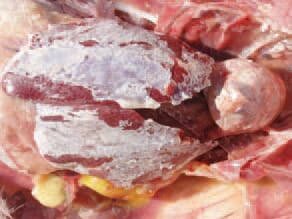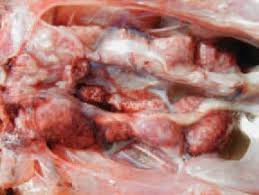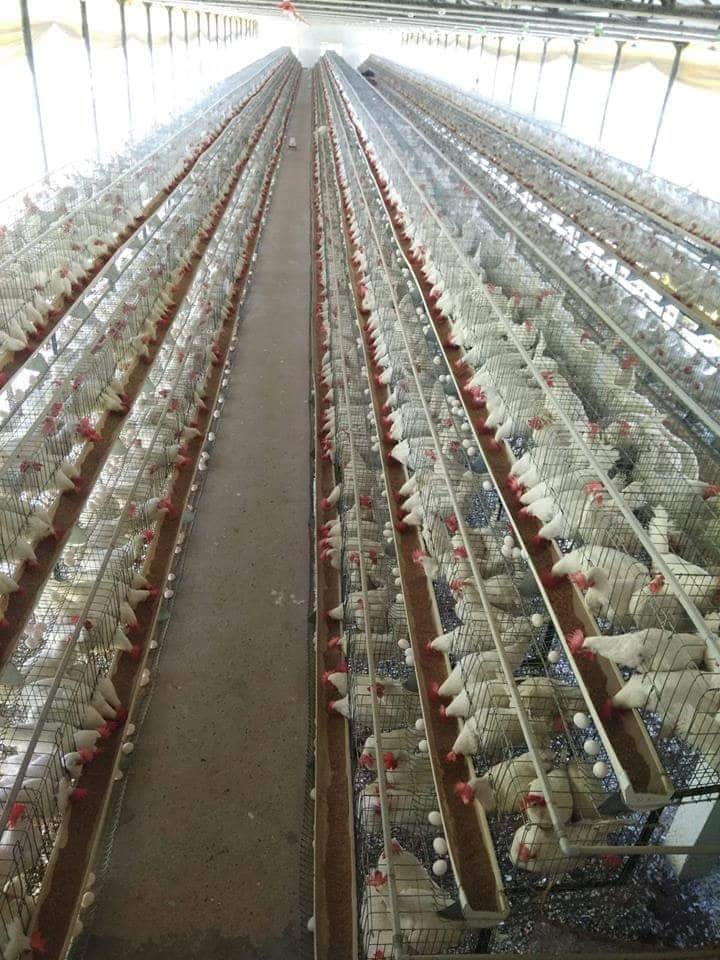A New Look on Gout (Avian Urolithiasis) in Poultry
Kaushik Pal1 and Melody Lalhriatpuii2
1 North 24 Parganas KrishiVigyan Kendra, Ashokenagar, 24 Parganas, West Bengal, India
2 National Dairy Research Institute, Eastern Regional Station, Kalyani, West Bengal, India
Introduction:
Poultry are kept for meat and eggs production. They provide a major portion of animal protein to the people throughout the world. Feed cost accounts for about 65-70% of the total cost in poultry/broiler production. Attempt has been made by the farmers to increase the growth rate in birdsthrough various managemental efforts, which may be economically feasible but may cause health disorders. In the process, the health of the vital organs is neglected which has resulted in increased incidence of metabolic disorders. The kidney is a vital organ of the bird with diverse metabolic and excretory function likeremoval of metabolic wastes and toxic products, regulation of blood pressure, blood volume, conservation of body fluids and electrolytes. A common disease among humans, reptiles and poultry (especially broilers) is gout.Gout or Avian Urolithiasis is the abnormal deposition of uric acid in the body. It occurswhen the level of uric acid (a by-product of the breakdown of dietary proteins usually excreted in the urine) in the blood exceeds the ability of the kidneys to remove it.
Avian species excrete nitrogenous wastes as uric acid. Renal dysfunction decreases the clearance of uric acid from the blood, which results in hyperuricemia with precipitation of insoluble products within the kidney itself or other organs, leading to urate deposition. Gout is commonly observed in chicken as they are uricotelic and lack the enzyme uricase. In gout, blood levels of uric acid can be as high as 44mg/100ml as compared to 5-7mg/100ml in a normal bird. Urate deposits are white and semisolid and must be differentiated from yellow fibrinous or purulent inflammatory exudates that are secondary to infectious causes, such as synovitis, peritonitis, perihepatitis, and pericarditis
Types:
The gout is mainly characterized by retention and build up of urates in tissues. It is seen as two separate syndromes. In articular or synovial gout, the uric acid crystallizes in the joints (most often the metatarsal and phalangeal joints), ligaments, and tendon sheaths of birds and tends to be severely painful. Diagnosis of articular gout can be made by the identification of gout tophi-whitish yellow, subcutaneous and intra-articular deposits that demonstrate uric acid crystals upon staining. Additionally, unless the underlying condition can be identified and corrected or controlled, new tophi will appear very rapidly. A bird with articular gout prefers to sit on a flat surface instead of perching because of the pains. If forced to walk, the bird becomes noisy due to discomfort. Male birds are susceptible to articular gout, and the common age for this affliction is four months and above. In chronic cases, urate precipitations could be observed in the trachea, the comb, wattles etc.
In visceral gout, uric acid deposits are found in the liver, spleen, pericardial sac (the covering of the heart), kidneys (renal tubules), and air sacs. The urate deposits on serous coats resemble a chalky white dust. Visceral urate deposits are generally due to renal failure. Possible causes for this could be obstruction of ureters, renal damage or dehydration. Acute death is often the only clinical sign noted. Serum uric acid levels are seldom elevated with visceral gout. The genetic, nutritional, or environmental factors that predispose a bird to gout are not fully understood.
Causes:
The cause of gouts is often difficult to determine as the original kidney damage may occur long before the onset of gout mortality. Possible factors that can cause or contribute to gout are nutritional, infectious and toxic.
Nutritional :
Nutritional or metabolic factors known to affect the kidneys including excess dietary calcium fed to immature pullets over a period of time which will result in kidney damage that may lead to gout. This could result from a feed milling error, accidental delivery of layer feed to a growing house, or excessively early use of pre-lay diet (i.e. before 15-16 weeks of age). Phosphorous has been shown to partially protect the kidney against calcium-induced damage. Phosphorous act as a urinary acidifier and prevents formation of kidney stones. Marginally low available phosphorous in grower diets has been associated with higher gout incidence. Sodium bicarbonate is sometimes used to improve egg shell quality or combat the effects of heat stress. Sodium bicarbonate can contribute to gout by making the the urine more alkaline, which with high levels of calcium, is an ideal medium for formation of kidney stones. High protein diet plays pivotal role to cause gout.Water deprivation, due to mechanical malfunction, may affect kidney function, but research has not demonstrated a direct result in gout. Vitamin A deficiency over a long period of time can cause damage to the lining of the ureters, but should be rare with modern vitamin formulation.
Infectious:
Viral agents known to be involved in gout are infectious bronchitis (IB) and avian nephritis virus (ANV). Infectious bronchitis is a highly contagious virus that normally involves the respiratory tract, but can also affect the reproductive and urinary systems. Certain strains of bronchitis, termed nephropathogenic, have a special predilection for the kidneys.
Avian nephritis virus, an enterovirus that affects the kidneys, has been associated with kidney disease and serious outbreaks of mortality in Europe and Asia. Although most information at this time suggests only a subclinical role for avian nephritis virus, research has shown avian nephritis virus inoculated into healthy chickens will cause inflammation of the kidneys and could lead to gout.
Toxin:
Poisonous substances (toxin), while widely distributed in nature, are not considered major cause of production loss or disease in poultry in most countries. However, problems can arise from nephrotoxic substances. Some potentially toxic substances are used on a routine basis, while others are the result of accidental exposure. Antibiotics, such as sulfas and aminoglycosides, are eliminated from the body via the kidneys and are potentially nephrotoxic, particularly when water intake is restricted. Disinfectants and insecticides, when used according to manufacturers’ recommendations, are safe and effective, but a miscalculation of dosage can result in toxicity.
There are several mycotoxins that are nephrotoxic and /or hepatoxic in laying hens, including Ochratoxin A, Oosporein and deoxynivalenol (DON). The kidney and liver damage caused by ingesting these mycotoxins can cause gout among other clinical signs.
Signs:
In case of articular gout, joints may be enlarged, stiff, and painful. Continual shifting of weight from one foot to the other and have a shuffling gait. The bird may be unable to perch, spending most of their time on the floor of the cage. If the wings are affected, the bird may be unable to fly. If internal organs are involved, other signs include decreased appetite, lethargy, weight loss, abnormal droppings and change in temperament.
Diagnosis:
A diagnosis of gout involves analyzing the diet, environmental factors, availability of fresh, clean water, and a thorough history of previous health problems and treatments. X-rays and blood tests may also analyze a fluid present in the joint or biopsy may be useful. Uric acid crystals found in joint fluid or tissues will confirm the diagnosis.
Treatment :
Treatment will depend on whether there’s an underlying dietary or environmental cause. If so, this must be remedied. Also, if the cause of the gout is due to improper nutrition, put bird on a low protein diet and may supplement with Vitamin A. If bird is dehydrated, fluids should be administered. Allopurinol (10–30 mg/kg, PO, bid) and Colchicine (0.04 mg/kg, PO, sid-bid) may be useful in the control of articular gout.Most birds with gout must be treated for the rest of their lives. If therapy is discontinued, there is a possibility that the painful signs may reappear. Although there is no cure for gout, it’s important for every bird owner to keep an eye out for symptoms, while also providing proper nutrition; an adequate source of Vitamin A, either from leafy, green vegetables, or vitamin supplements and fresh, clean water.
Nutritional management:
A dietary nutrient management is the most important factor which can be applied at farmer’s level. The grower diets should contain no more than about 1% calcium in powder (i.e. less than 1 mm mean diameter) form up to 15-16 weeks of age. A high calcium intake in immature pullets can cause serious kidney damage. The dietary content of available phosphorous levels should be adequate, typically 0.45-0.50% in grower diets. Insufficient phosphorous predisposes the kidneys to calcium damage. The pre-lay diet should not be used before 15-16 weeks of age, and should not be fed until the flock shows signs of sexual maturity (blooming of the combs and wattles). Do not supply more than the recommended 2.50-2.75% calcium in the pre-lay diet. If sodium bicarbonate is used, use only enough to supply 20-30% of the diet’s recommended sodium content (with the remainder coming from salt, NaCl). A flock with gout should not be medicated with sodium bicarbonate or fed a diet that is highly alkaline (i.e. high levels of sodium or potassium). Use of any urine acidifiers may be useful given in water or feed Viz. Potassium chloride @ 1g per litre water up to 24 hours, Ammonium chloride @ 2.5 kg/ton feed for 7 days or Ammonium sulphate @ 2.5 kg/ton feed for 7 days. Review all calcium and available phosphorous levels in the feeding program and follow the recommendations for the age and variety. Pullet and layer feeds should be routinely analyzed for calcium and phosphorous. Feed samples could be assayed for the presence of the mycotoxins, citrinin, ochratoxin and oosporein. Water deprivation should be avoided in growing and laying flocks.
Control:
Gout, when recognized as a problem in field cases, is likely to be a multi-factorial problem and identifying a specific cause is often difficult. Another reason for diagnostic difficulty is that kidney damage occurring during the growing period often has no apparent signs until the birds later come into egg production and are fed high calcium diets. Field cases and research have demonstrated the importance of interactions between two or more contributing factors, especially nutrition and infectious bronchitis.
Summary:
The presence of gout mortality in poultry indicates some form of kidney damage has occurred at an earlier time in the flock’s life. Research supports a strong link for bronchitis and calcium-phosphorous imbalance as major causes of gout mortality. While this is likely to be the underlying cause for most cases of gout, other factors such as nutritional and electrolyte imbalance, mycotoxins and water deprivation need to be recognized as possible contributing factors. Likewise, any diet that increases urine alkalinity in combination with high calcium can contribute to gout mortality in poultry. If gout does occur in a flock, mortality can be reduced by increasing the acidity of urine to dissolve existing kidney stones or to prevent additional kidney stones from forming.
VISCERAL GOUT ( AVIAN UROLITHIASIS) IN COMMERCIAL BROILERS & LAYERS
Articular Gout in Poultry
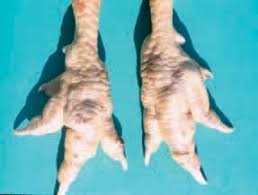
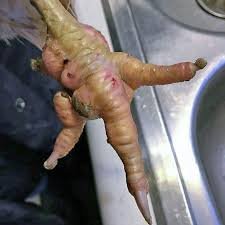
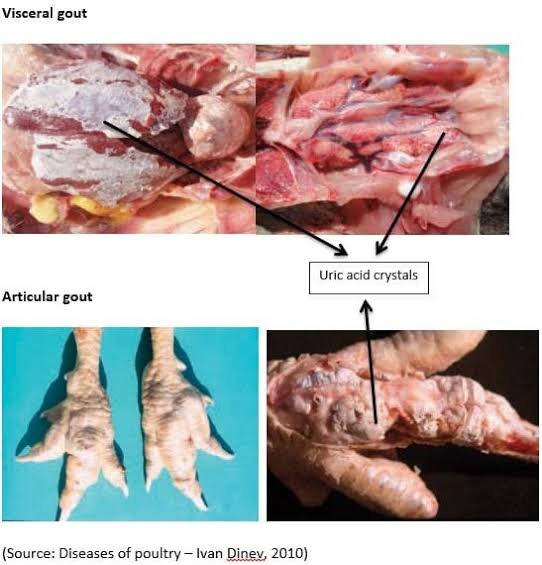
Visceral Gout in Poultry
